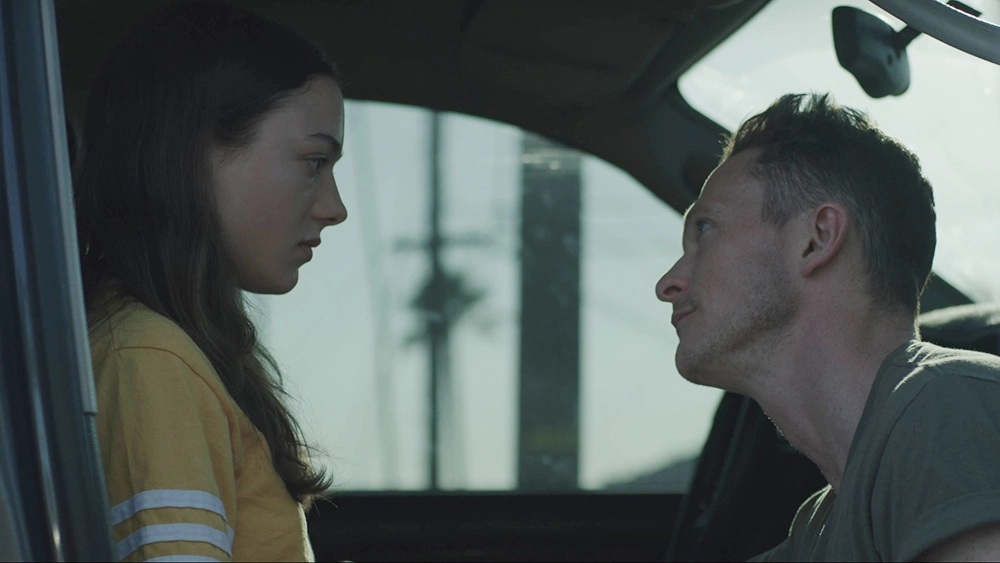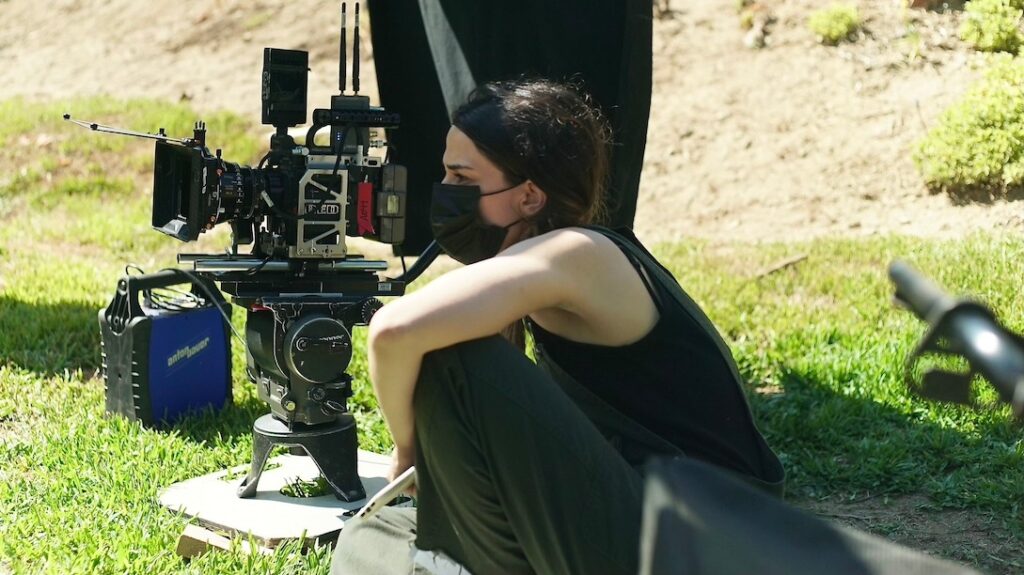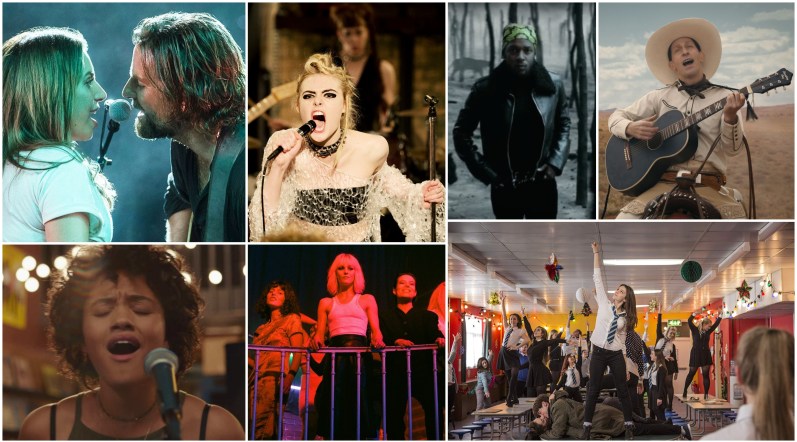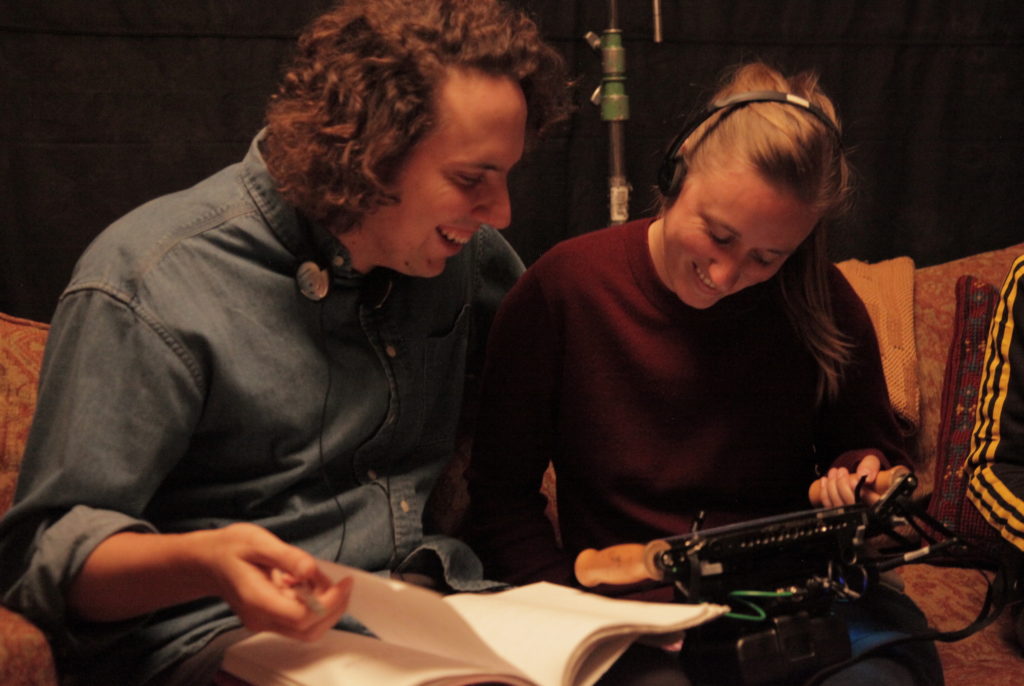With an evocatively-titled screenplay, two powerful leading roles, and a Cannes-approved short to work off of, JAMIE DACK had a lot going for her when trying to get her feature directorial debut off the ground. But as with any indie film (especially one tackling serious social issues), it took a lot of determination and talent to see the film through to completion. That film, PALM TREES AND POWER LINES, has boosted the career of the NYU film school grad, who in addition to numerous awards, was selected for Panavision’s New Filmmaker Program as well as Film Independent’s Fast Track Fellowship.
Dack first made Palm Trees and Power Lines as a short film that screened as a Cinéfondation Selection at the 2018 Cannes Film Festival and was selected as a Vimeo Staff Pick. The feature-length adaptation — starring Lily McInerny as a teenager who falls into a predatory relationship with a man (Jonathan Tucker) twice her age — has followed in those footsteps of accolades since its premiere at the 2022 Sundance Film Festival. The film won Dack the Sundance Directing Award, followed by the Deauville Film Festival Jury Prize, the Torino Film Festival Best Feature and Best Screenplay Awards, and nominations for four Film Independent Spirit Awards, including Best First Feature, Best First Screenplay (Dack and Audrey Findlay), Best Supporting Performance (Tucker), and Best Breakthrough Performance (McInerny).
Now, the cherry on top of all those honors is that general audiences can see the film for themselves when Momentum Pictures releases Palm Trees and Power Lines in theaters and on demand on March 3. We had the chance to speak with screenwriter/producer/director Jamie Dack about her breakout feature debut.
——
COLIN McCORMACK: Back when you were making the initial short of Palm Trees and Power Lines, how early or late did you start to wonder whether there was more to explore at feature length?
JAMIE DACK: I feel like I thought about it as a feature pretty quickly. The short is pretty contained and so there were definitely, even when I was writing it, thoughts I had of things I wanted to explore further. But once the short was out in the world on the festival circuit and it was a Vimeo Staff Pick and people started seeing it, it was really the responses coming from people, specifically women, about ways in which they related that really sealed the deal for me that I wanted to keep exploring this further.
CM: And then in terms of bringing on additional collaborators, how did [co-writer] Audrey Finley come on?
JD: Yeah, so I was writing the feature and I had written a number of drafts and there were many [aspects] that are still in the feature that I eventually made. But there were other ways in which it wasn’t exactly what I wanted it to be. I knew that I wanted to construct the script to follow the stages of grooming and it was at that point that I started putting it out into the universe and asking everyone that I encountered basically, “Do you know anyone that would be a good co-writer?” Because there was no one in my life at that time that was right for that. And eventually an executive I met with said, “I think I might know someone.” And he introduced me to Audrey.
CM: And was that process of co-writing like knocking drafts back and forth, or did she do her own passes on your script? How did that collaboration work?
JD: We worked together every day and we kind of outlined together and then we would go write scenes separately and come back.
CM: The short wasn’t made to be a proof-of-concept strictly, but did it end up serving as one in a way? Was it easy send that to potential financiers as opposed to doing it all on a pitch or basing it all on the script?
JD: For sure. I think because the short was set in the same world and essentially has the same character, this teenage girl, it definitely served as a proof of concept even though it wasn’t meant to be when I made it. And also the short’s reception, it premiering at Cannes, was incredibly helpful in getting the feature financed and having people believe in my vision.
CM: I imagine the casting must have been a really delicate process. Who came on board first, Jonathan or Lily?
JD: Lily came on board first. I knew that I really wanted to find someone new and exciting that people had never seen before. And I wanted audiences to be able to get lost in this person’s performance and really feel like they were watching a real teenage girl and not be like, There’s so-and-so actor playing this teenage girl. Because that can really take you out of it. And Lily was young enough; I didn’t want someone who was 25 playing a teenager. So I worked with an awesome casting director [Kate Antognini] who really understood what I was looking for, and she had found Lily. We had Lily audition and her tape was incredible.
CM: Did you have a mandate that you wanted somebody 18 and older for the delicate nature of the scenes?
JD: Yes, I think it would’ve been incredibly challenging to make this film with someone who was under 18.

CM: Because Jonathan’s character is so malevolent in certain ways, but also layered, was it hard to find actors willing to go there? Or did it seem like a role that people were really interested in pursuing?
JD: You know, it was both. There were some actors that were really interested in doing it and I think are really brave actors who were very excited by this sort of material. And then there were definitely people who were like, “This isn’t my brand,” or people’s agents saying, “This isn’t what he likes to do.” So I applaud Jonathan for his bravery, which is one of the reasons why I’m so happy that he’s being recognized with his Spirit Award nomination for this role.
CM: Given any budget or time constraints, were you allowed time for rehearsals or chemistry tests or anything like that between Lily and Jonathan?
JD: I don’t know how to explain it, but I just knew with the two of them, so I cast them without ever doing a chemistry read, which maybe sounds crazy. I really just knew that they were going to be able to do it. And we could have rehearsed more, but I actually didn’t want to. We did rehearse a little bit, and we picked a few scenes to go through, but I really wanted to keep it fresh and new for the day of shooting.
CM: In terms of your own prep work for tackling some of the more intimate scenes, how early were you starting to form a game plan or figure out what would work best for not only you as a director but for Lily and the other actors in the scenes?
JD: I think I knew in terms of the delicate nature of the whole film that Lily and Jonathan really needed to be comfortable with one another. So that began when Lily and I came out to LA and I started facilitating meals and hangouts together. And Jonathan said, “I’d love to go do an animal Alexander Technique session with Lily. What do you think of that?” I was like, “Great, you two go off and act like animals together and crawl around on the floor and become comfortable.” It really was just things like that.
CM: You mentioned LA and I was honestly surprised to learn that the film was shot in LA. It’s not the usual LA that we see on screen, so did you have locations in mind when you were writing it, or was that all something that you found along the way?
JD: So it’s actually not supposed to be set in LA. It’s supposed to be set in some part of southern California that we don’t know, some suburb. The short was shot in San Diego, and I had hoped to shoot the feature there as well but because of budgetary reasons, we pivoted to shooting in LA. I even VFX’d out a building [because] I didn’t want people to know that LA building. A story about teenagers in LA is a very specific thing and that wasn’t what I was doing. The short and the feature stemmed from a series of 35-millimeter film photographs that I was taking in Southern California, so I knew that it was going to be set here. It was a visual world that I had kind of become obsessed with. It’s that title because she’s quite literally seeing those things and I feel like the suburban malaise that she’s experiencing, which is captured in these photographs, is one of the things that cause her to be vulnerable to his manipulation.
CM: You mentioned having to pivot in terms of the location. Was there any scene or moment or day of production that stands out in your mind of when you had to problem-solve on the ground or pivot?
JD: Nothing’s coming to mind in terms of pivoting, but there’s the scene, “BRB – chasing sunsets,” where they’re sitting on his truck. It is really hard to shoot a dialogue scene, the whole thing, during magic hour and during sunset and capture all of it. So that was a scene where we were just going as fast as we could and making decisions as we went and scrapping shots.
CM: How long was your filming schedule?
JD: 25 days.
CM: And it was all during COVID, right?
JD: It was all during COVID, which was very challenging. I felt like during my directing, I’d literally be like “thumbs up” to my actors all the time, which felt so dumb, but they couldn’t see my face [under the mask].
CM: Since it was LA, was it during any of the spikes or the lulls?
JD: It was during Delta, it was pre-Omicron. We were scared. And what’s crazy is no one on the crew or cast got COVID once. But we were tested multiple times a week and my producer [Leah Chen Baker] and I were always just like, “Let’s hope this shoot does not get shut down.”
CM: You premiered at Sundance and you won the directing award during one of the virtual Sundance years. When was the first time you actually got to see the film in a theater with a group of people?
JD: I’m trying to think if I’ve ever sat through it in a theater with a group of people. I may not have, but it did play after Sundance at the San Francisco Film Festival, so an audience saw it there. But then what was really kind of special and healing for me, Lily, and Jonathan — considering Sundance had been virtual — was our European premiere at Deauville. That was a theater of like a thousand people, and we watched some of it, and then all three of us were like, “We’re gonna leave. We’ve seen it a million times.” But that was a really, really special experience.
CM: How have Q&A’s or audience responses varied depending on the different parts of the world that you’ve screened at?
JD: I feel like a number of my sensibilities as a filmmaker tend to be European, whatever that means. Whether it’s pacing or just the subtle nature of things, I feel like in the U.S. and in Hollywood, things are really fast and everything’s explained. And so the short had played Cannes, which I felt really made sense for the work. In Deauville, people really responded to the film as well, and we won the jury prize there. Then again, it did well out of Sundance too, so I don’t know.
CM: Maybe American audiences aren’t quite as prudish as we think.
JD: Totally. But you’re reminding me of another thing. I’m making generalizations here, of course, but I do feel like in European cinema they aren’t as afraid of things. They aren’t as afraid of some of the subject matter that I’m tackling.
CM: What’s next for you?
JD: I’m working on two features at the moment. One is my own idea and one is an Italian novella that I optioned the rights to.
__
Thank you to Jamie Dack for talking to us about PALM TREES AND POWER LINES. Learn more about the film at the Momentum Pictures website.
If you’re an independent filmmaker or know of an independent film-related topic we should write about, email blogadmin@sagindie.org for consideration.




